without having to sacrifice a dip in user experience which came from blocking third party cookies. In terms of advertising, Privacy Sandbox details different way its aims to provide targeted ads without the need for third party cookies. The first way is through topics. Topics will be recognisable categories that a browser infers based on the pages that you visit e.
sports. This means that the
specific sites you’ve visited aren’t shared across the web. Additionally, Google are providing the option to remove any topics you don’t like vnpay database or disable them completely in Chrome settings. Federated Learning of Cohorts (FLoC) is a proposal to cluster users with similar browsing patterns into large groups; however, this development ended in 2021. Finally, Google aims to provide ads based on the websites you have previously visited or for products you have recently viewed.
Once again this won’t rely
on the use of cookies, but rather as you browse the web, the sites of advertisers you’ve visited can inform the browser that they want to show you ads in the future. This includes showing the browser the specific ad they want to show you and how much they’d pay to show you an ad. Currently, this approach is called First Locally-Executed Decision over Groups.
The Future of Google Analytics
As previously mentioned, Google Analytics also relies on third party cookies to collect its data and therefore it will be monumentally affected by the upcoming phase out. It is unclear whether or not Google will create a cookie-less tracking alternative in order to preserve GA, such as a server side analytics alternative. That being said, GA4 the new Google Analytics update, will use AI insights and predictions powered by machine learning which will alert you to significant trends in your data and hopefully help close the gaps that cookie-less tracking is causing.
Despite this, until the third
party phase out occurs, it is still important that you have analytics set up and updated to the latest version. Then, it’s time to start thinking about collecting and emphasising first party data. A Move Towards a First Party Data Strategy Fortunately, the third-party cookie phase out does not have to be a crisis for website owners who rely on this type of data collection to provide insights.
Instead, a potential solution
could lie within first party data and creating a new strategy based around it. What is First Party Data Any company with a customer has and providing continuous support to customers uses first party data. First party data is the information that you. Can directly get from your customer relationships, and it is the foundation for. Understanding them based on
Whilst this data can come from
a variety of places (on and off screen), the most material data common first . Party data sources are: website, mobile apps, email, SMS, point of. Sale and CRM. Additionally, the data can be. More accurate and current since you aren’t relying on any external sources. A First Party Data Strategy While most brands already use this data to a certain extent, it is possible to. Create a first party data strategy, which will be vital. Preparation to the third-party cookie phase out.

